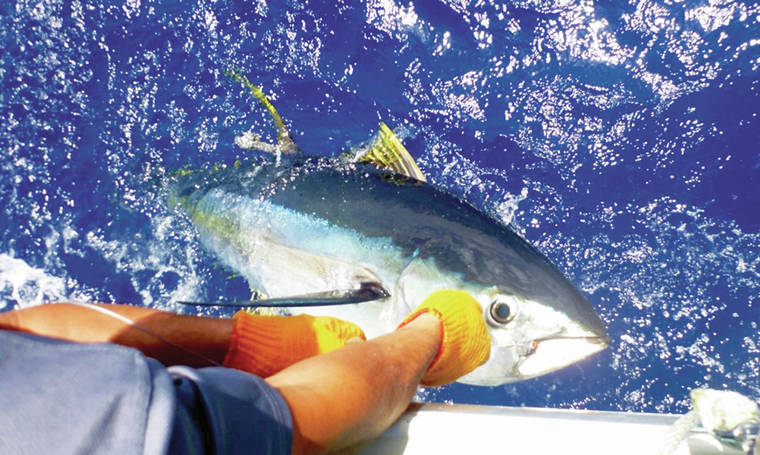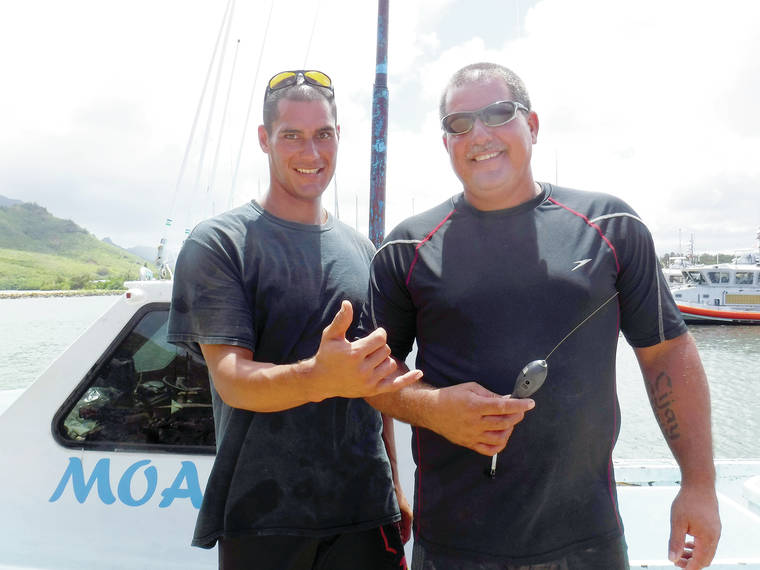LIHU‘E — Where do Hawai‘i’ʻs ahi, yellowfin tuna, go when they’re not found in island waters?
Do they stay near the shore, or swim into entirely different parts of the ocean?
Kaua‘i and Kona anglers are working with marine scientists to find out, using cutting-edge satellite tagging of mature tuna.
A new paper in the journal Frontiers in Marine Science (published March 19, 2020) reveals intriguing details about Hawai‘i-caught ahi. It is entitled “Complex dispersal of adult yellowfin tuna from the Main Hawaiian Islands.”
Some ahi appear to stay close to home, while others range far, far afield, according to the tagging research. They seem to be around the Hawaiian Islands when water temperatures are most appropriate for spawning.
Local ahi stocks appear healthy, although some tunas elsewhere have been overfished — notably Pacific bluefin and juvenile bigeye in the Western Pacific.
Scientists and anglers are anxious to be sure island-associated yellowfin remain a healthy resource for years to come, said Kevin De Silva, a Kaua‘i fisherman active in the tagging research.
“Generations of Hawai‘i residents have depended on the ahi fishery, and we want to be certain that our grandchildren and their grandchildren can continue to enjoy fresh, locally caught fish for their poke, sashimi and ahi steaks,” De Silva said.
New research conducted off Kaua‘i is one of the first pieces in a larger inquiry designed to determine whether ahi are strictly a local population or part of a Pacific-wide population, as is currently assumed.
The tagging data also bares the perilous life of tuna. They often do high-speed dives to water nearly a mile deep to escape predators like false killer whales. Sometimes it works and they escape. Sometimes not.
“Fisheries scientists have been calling on ways to elucidate the complex lifestyles and migrations of long-lived tuna and billfish in order to improve population assessments, and to assure fisheries sustainability against changing oceans, fleet dynamics, regulations and seafood markets,” write the authors, Chi-Hin Lam, Clayward Tam, Donald Kobayashi and Molly Lutcavage, who lives in Lihu‘e.
Lam and Lutcavage are associated with the Large Pelagics Research
Center at the University of Massachusetts and the Hawai‘i-based Pacific Islands Fisheries Group. Kailua resident Tam is with Pacific Islands Fisheries Group and Kobayashi with the National Oceanic and Atmospheric Administration’s Pacific Islands Fisheries Science Center in Honolulu.
Local anglers who assisted in the research include De Silva, Ryan Koga, Eric Hadama, Curtis Matsumura, Mark Oyama, Nathan Abe, Mike Abe, Gary Shirakata, Kevin Awa, Marvin Lum, John Kauhaihao, Craig Koga and Cory Nakamura, as well as Basil Oshiro, Gavin De Silva, Bryan Hayashi, Alan Horikawa, Joe Koerte, Ryan Kusunoki, Justin Pasamonte, Lance Gilbert and the late Reid Shigeki Takayama.
They were responsible for everything from “fabricating tagging equipment to recommendations on how to catch and handle the big ahi to ensure optimal survival,” said Lutcavage.
They conducted tagging research from 2014 to 2016, collecting samples from dozens of harvested tuna and attaching satellite tags to 19 ahi weighing between 90 and 200 pounds. Those fish were then released.
The satellite tags record where the fish swims, how deep, how fast and at what water temperature they are found. The tags are programmed to automatically release from the fish at nine to 12 months, at which time they float to the surface and begin reporting the data to receivers on satellites. Sometimes the tags release prematurely, but even shorter tracks reveal many surprises.
“Adult yellowfin tuna frequenting the Main Hawaiian Islands have more complex movements than previously assumed,” the authors said. Some fish seemed to stay around the Hawaiian Islands. Others went off on long swims as much as 1,280 miles from the islands in different directions in less than 60 days.
One of the fish appeared to have been eaten by a warm-bodied predator, likely a false killer whale or short-finned pilot whale, Lutcavage said. That was determined by the tag’s records of the fish’s final attempts to escape, by the fact that the tag suddenly stopped sensing light, and by temperature information that suggested the tag had passed into the digestive tract of a warm-bodied animal — an animal with a body temperature consistent with a false killer or pilot whale.
In the daytime, ahi normally stay within the top 600 feet or so. Whales do, too, but separate whale-tagging studies show they also sometimes do fast, deep dives.
“Rapid descents to deeper depths by tagged yellowfin mirrored depth profiles of potential predators, especially pilot or false killer whales: the dash to depth may be an effort by a yellowfin to outrun its predator,” the paper said.
Several of the tagged tuna showed indication of high-speed deep dives. One of the tuna dove from 415 feet deep to 4,650 feet in five minutes, and managed to escape. Four more engaged in deep, fast dives right before their tags came off — so their fate is not known. The one tuna was clearly eaten and its tag spent some time in a whale’s body before popping to the surface to report its data.
In addition to the tagging studies, Lutcavage, Tam and local fishermen collected samples from harvested fish, and were able to show that many are in spawning condition when around Hawai‘i. Ahi spawn multiple times annually, and generally when water temperatures are between 75 and 82 degrees. Stomach contents confirm that the fish are generalists, eating small fish, squid and crustaceans.
Lutcavage said her team plans additional tagging work off Kaua‘i and across the state, to continue to build an understanding of ahi biology and behavior. Ahi are so important to local culture, economy, food security and diet that the information is critical to their sustainability and to continued access to the fishery, she said.
Here is a link to the paper: doi.org/10.3389/fmars.2020.00138
•••
Jan TenBruggencate is a longtime Kaua‘i science writer and author.




Aloha and Congratulations and mahalo to all the fishermen who did the hard work of catching, tagging, and releasing all those ahi, especially the big ones. The hardest job of all must have been releasing the tagged big tunas, as any fisherman will tell you. How interesting to study where fish go and how long they live.
It would be nice if as much effort would be put into the understanding of why some people live so long, for example, all those wonderful Filipino and Japanese seniors who live on the Westside, Living to their late 80’s, 90’s, and over 100…!
And as well why more and more people island wide are passing away early in their 40’s. 50’s, and 60’s…?
There is one common factor all these people share that could explain the life longevity or shortivity of each person.
All of these people eat food. It just might be the food…! Some scientists say it is
The Food…!
When you pass away in your late 90’s and into your 100’s, it is realistic to say they passed away from old age…!
But if you pass away at 30 or earlier on up to your 70’s, it is realistic to ask what disease they died from…?
Or better, or maybe worse, what treatment were they taking…?
Often an aggressive treatment, like chemo therapy and radiation for cancer is a likely cause of early death, the treatment being more toxic and lethal than the patient can handle. some people die within days, weeks, or months of starting cancer treatment.
More importantly, what caused the cancer…? Was it decades of eating food with countless chemicals and sugar, or animal flesh, or dairy products that accumulate in the body to cause terminal diseases…?
Well then what is being eaten by these lucky Kaua’i Asians on the Westside for them to be living so healthy, active, and long…?
Are these Centenarians eating foods they and their ancestors were raised on, traditional foods from their native countries…?
…vs. foods, eaten by people who pass away early, like from eating modern Junk Foods, and foods filled with too many chemicals, too many sugars, too many cancer causing petrochemicals…we guess someone needs to ask…you know like in a survey of them or asking their family members if they passed away after reaching the really old age mark, or when they were still to young to die.
What if looking into what people ate predominantly eating during their lifetime pointed to the natural path that leads to a healthy longevity…?
And what if eating sugars, sodas, food additive chemicals, and even prolonged use of prescription drugs all pointed to obesity, diabetes, and other killer chronic degenerative diseases…!
And what if truth be known that tobacco, alcohol, and street drugs were known to be catalysts of diseases that accelerated diseases that led to an early sickly death…!
Certainly, like fishing boat captains that steer the boat to fish, the study of food consumption may tell people how to steer the their life and bodies to healthy longevity…!
Let’s follow the lead of these courageous sea going fishermen and like them investigating what fish eat and what makes fish long lived, let’s look into the human side of Optimal Active Healthy Longevity with food that steers a course of Health.
Besides not being sick, it saves On time and cost and suffering of doctor visits, drugs, and body mutilating surgeries…!
Mahalo